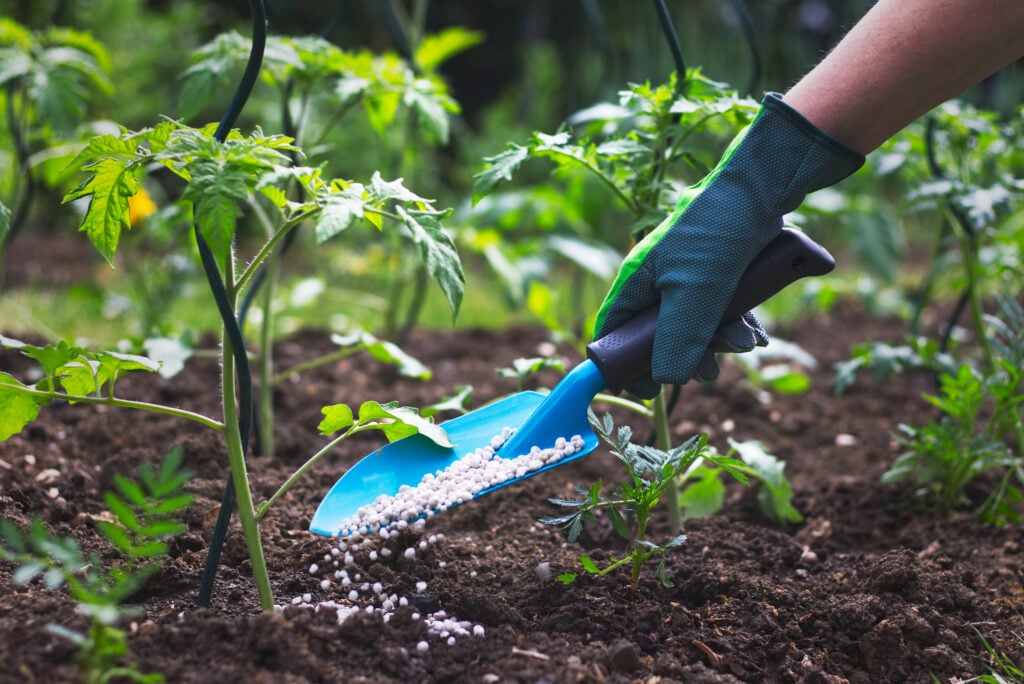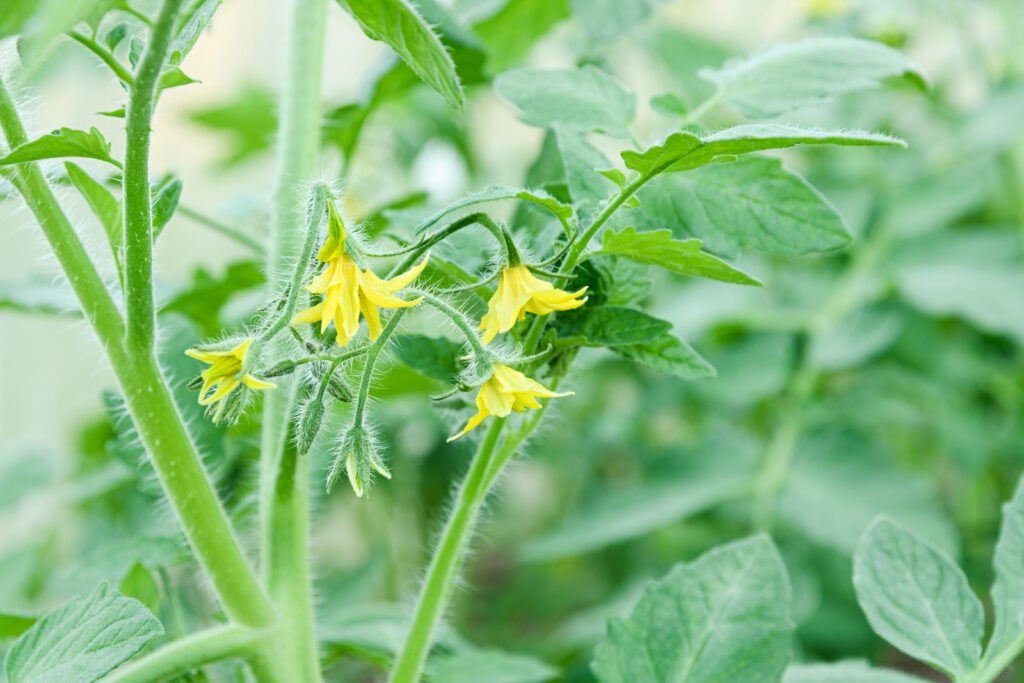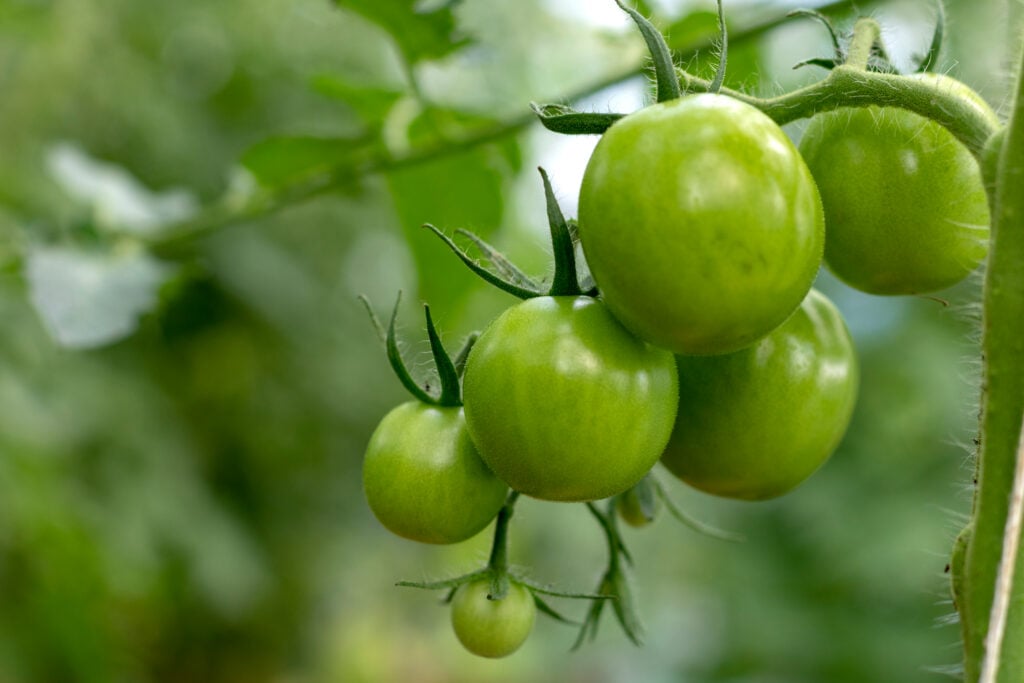One of the most critical activities a gardener can perform when growing tomatoes is providing fertilizer with the Best NPK (nitrogen, phosphorus, potassium) ratio. This will provide gardeners with a higher yield and tomatoes that not only look better but taste better regardless of the tomato variety you grow.

Keep in mind that NPK ratios for tomatoes are not a one-kind-fit-all solution. Tomatoes transition through 4 growing stages: seedling, vegetative, flowering, and fruiting. After years and years of growing thousands of tomatoes in my backyard, I’m confident my NPK Ratios will help you. I’ve also compiled a list of the best types of fertilizer for tomato plants over the years that have helped me improve all aspects of growing tomatoes. And don’t skip my expert tips!
NPK Ratios for Tomatoes
Seedling NKP Ratio
The Seedling Stage of a tomato occurs approximately 2-4 weeks after planting tomato seeds. During this stage, tomato plants typically do not need fertilizer. In some cases, though, seedlings require a fertilizer with an NPK ratio that will help provide them with:
- Establishment of a root system
- Healthy initial foliage growth
The optimal NPK ratio for tomatoes in the vegetative stage is 10-10-10:
- Nitrogen (N): 10
- Phosphorus (P): 10
- Potassium (K): 10
It is critical that the ratio of Nitrogen is equal to Phosphorus and Potassium. Nitrogen will promote a healthy initial amount of leafy green growth. It should be noted that too much nitrogen can overwhelm the tomato plant with leaves while inhibiting root growth.
A balanced Phosphorus (P) in the NPK ratio may also be needed during the seedling stage. It will enable the tomato plant to grow strong roots faster. This will allow your tomato plant to absorb water and micronutrients efficiently and help it build a foundation to fight off environmental factors like disease, pests, and drought.
Finally, Potassium (K) is strongly recommended to help promote overall health. This is so important because when transplanting seedlings from indoors to your garden, they will be exposed to potentially extreme environmental elements that they will need to withstand for the first time.
Nutrient burn is one of the biggest risks of applying fertilizer during the seedling stage. Nutrient burn occurs when the plant receives too many nutrients, ultimately leading to death. To prevent this, providing more frequent fertilizer applications than other stages is recommended, but with half-strength solutions to help acclimate your plant to nutrients.
Vegetative NKP Ratio
The Vegetative Stage of a tomato occurs approximately 4-6 weeks after planting tomato seeds. During this stage, tomato plants need a fertilizer with an NPK ratio that will help provide them with:
- strong root system
- branch growth
- leaf foliage
The optimal NPK ratio for tomatoes in the vegetative stage is 18-18-21:
- Nitrogen (N): 18
- Phosphorus (P): 18
- Potassium (K): 21
This will provide a high-concentration and slow-release of nutrients that will promote vigorous growth of the plant. According to the Ohio State University College of Food, Agricultural, and Environmental Sciences, “an application of a starter fertilizer at transplanting will help your tomatoes grow faster and flower sooner.”
The most important part of the NPK ratio during this time is Nitrogen (N). Compared to the other growing stages, a higher concentration of Nitrogen is needed to promote abundant green leaf growth for tomato plants. The green leaves allow the plant to capture and turn sunlight into energy, supporting strong growth and plant structure.
The higher concentration of Phosphorus (P) in the NPK ratio is critical to overall health during the vegetative stage. It will enable the tomato plant to grow strong roots, allowing for more effective and efficient water intake. This will not only help with growth but also its resilience in fighting off disease and pests.
Finally, the higher concentration of Potassium (K) in the NPK ratio is vital during the vegetative stage to help promote health. More specifically, without the proper amount of Potassium, the tomato plant will struggle to withstand disease, extreme heat and cold, and fungus.
Flowering NPK Ratio
The flowering stage of a tomato occurs approximately 6-8 weeks after planting tomato seeds. During this stage, tomato plants need a fertilizer with a balanced NPK ratio that will promote:
- robust flower growth
- robust root development; crucial for energy transfer, blooming, and fruiting.
The optimal NPK ratio for tomatoes during the flowering stage is 10-10-10:
- Nitrogen (N): 10
- Phosphorus (P): 10
- Potassium (K): 10
This balance of nutrients will shift tomato plants’ energy from plant growth to flower and fruit growth, as seen in the image below.

During the flowering stage, tomato plants need less Nitrogen. This will allow the tomato plant to shift its energy from plant growth to flower and fruit growth. Excess Nitrogen leads to excess foliage at the expense of flower growth.
Phosphorus is a nutrient that becomes more important during the flowering stage. A more balanced NPK ratio with Phosphorus allows the tomato plant to grow more flowers, which increases the likelihood of pollination and fruit growth.
The most important nutrient during the flowering stage of tomato plants is Potassium. The balanced NPK ratio with Potassium will help increase the quality, flavor, color, and even texture of tomatoes while they are growing. Not only this, but it is critical to help tomatoes ward off disease, pests, and environmental stressors that occur.
Fruiting NPK Ratio
The fruiting stage of a tomato occurs approximately 8-12 weeks after planting tomato seeds. During this stage, tomato plants will continue to need a fertilizer with a balanced NPK ratio that will promote:
- continual flower formation and health
- fruit set and development
- root strength and stability
- plant and fruit vitality and disease resistance
The optimal NPK ratio for tomatoes during the fruiting stage is 10-10-10:
- Nitrogen (N): 10
- Phosphorus (P): 10
- Potassium (K): 10
The balance of nutrients will continue to shift more of the tomato plant’s energy from plant growth to fruit growth, as seen in the image below.

During the fruiting stage, tomato plants continue to need a balanced ratio of Nitrogen. This will allow the tomato plant to shift its energy from plant and flower growth to fruit growth. Keeping the Nitrogen ratio at ten or below is recommended to help prevent excess foliage growth and promote flower growth.
Phosphorus continues to be critical during the fruiting stage. A balanced NPK ratio with Phosphorus allows the tomato plant to grow more flowers, promoting a higher volume of quality fruit that you can harvest throughout the summer into early fall.
The most important nutrient during the fruiting stage of tomato plants continues to be Potassium. The balanced NPK ratio with Potassium will help increase tomatoes’ quality, flavor, color, and even texture as they turn from green to red. Not only this, but it is critical to help tomatoes ward off disease, pests, and environmental stressors that occur.
It should also be noted that adding the nutrient Calcium is strongly recommended during this stage. Adding Calcium through Cal-Mag Fertilizer will help your tomatoes strengthen their skin. This fertilizer will also decrease the chance of deformities and decrease the chances of blossom end rot.
As seen in the video below, you can also organically apply Calcium to your garden by adding and burying eggshells into the soil where you grow your tomatoes.
Expert Tip
The most crucial expert tip for managing NPK ratios for growing tomatoes is to start with soil testing. Understanding your soil’s existing nutrient profile is critical because it informs you about what your plants have already received and what they need. This step is foundational because it helps determine all subsequent fertilization decisions.
Proper soil testing will guide you in selecting the appropriate fertilizer with the correct NPK ratio for each growth stage of your tomatoes. It helps avoid both under-application and over-application of nutrients, which can be detrimental to the overall health of your tomato plant. By understanding your soil’s NPK baseline, you can tailor your fertilization strategy to be cost-effective, environmentally friendly, and effective for your specific plants’ needs.
Remember, all other tips and growing steps are based on the findings of a soil test: it determines how you’ll balance the NPK during the various growth stages when to adjust for more or fewer nutrients, and even how much organic matter like calcium you might need to add to improve soil structure.
Frequently Asked Questions
No. While there will always be subtleties of NPK ratios for different tomato plants, hobbyist gardeners do not have to worry about different types of NPK ratios for different types of tomatoes.
No. If gardeners are worried about excessive stem growth that will fall on the ground and potentially become destroyed, then apply a 10-10-10 NPK ratio during the vegetative growth stage to limit nitrogen intake.
Yes, to minimize blossom end rot, maintain consistent watering and add calcium to the soil using crushed eggshells directly or as an eggshell tea water solution (soak crushed eggshells for a few days and apply calcium-rich water).
Learn More About Tomates
While providing the proper NPK ratio is just one tip for providing a higher yield of quality tomatoes, you can check out my other articles below to help make this the best gardening season ever!

Take away
Understanding the significance of the NPK Ratio for each stage of tomato growth is critical to the plant’s overall health. By providing the right balance of NPK in each stage, the tomato plant will almost always grow strongly and quickly. It will also have abundant flowers, providing quality and tasty fruit.